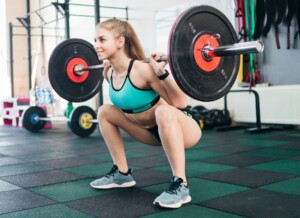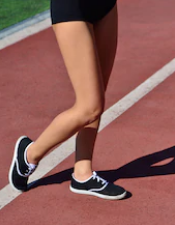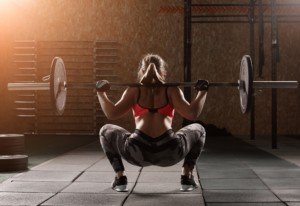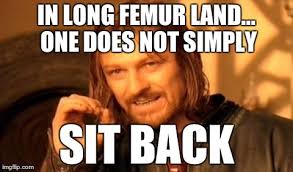
There’s a fool proof way to tell if your femurs are too long for decent parallel back squats.
If you can’t parallel squat, does this automatically mean your femurs are too long relative to the rest of your body, or is there a way to accurately determine this since other variables can prevent a parallel squat?
I’m a former certified personal trainer and have plenty of experience with relatively long femurs.
Some frustrated clients have asked, “How can I tell if my femurs are too long?” It’s easy to tell these trainees to just look at their legs.
If the thighs look out of proportion in terms of being too long, then you probably have long femurs.
However, what one person might think is too long, another person (who has long femurs) might think is normal.

Almost every anatomical illustration I’ve ever seen depicts the femurs as too long for the rest of the legs (in my opinion, anyways). The shins in anatomical illustrations are usually puny.
Another way people try to evaluate femur length is with a tape measure. The problem here is two-pronged:
1) Exactly where are the measuring points? And
2) For people of generous girth, it will be difficult to locate the hip bone.
Fool proof way to determine if long femurs are hampering your back squat.
And as you may already know, if a person’s torso is longer than their femurs, this can help offset problems with the back squat, even if their femurs are disproportionately long for their legs.
The best way to tell if long femurs are your problem (as well as a short torso) is to find a chair, bench or stool that — when you sit on it, your thighs are perfectly parallel to the floor.
If they are not parallel (meaning, the hips are higher OR lower than the knees), this test won’t be fool proof.
Next, make sure you’re sitting before a mirror, profile facing it. It’s mandatory that you be able to readily view your profile.
If you’re on a chair, sit off of it somewhat to give your calves room to move.
If you’re wearing the shoes that you normally squat in, that’s fine, but for optimal accuracy, do this test barefoot.
At all times during this test, keep feet flat on floor.
Place feet about shoulder width apart, toes pointed ahead.
Place feet so that knees are ahead of them as in a back squat, but keep heels on floor.
Viewing your profile, start leaning forward and maintain an arch in your lower back, as you would during a squat. Do not round your back.
The objective is to form a vertical line between your ankle and the back of your shoulder.
The back of your shoulder is where a barbell would be for the squat.
How far must you lean forward to create a vertical line between your ankle and the back of your shoulder?
In other words, the back of your shoulder (picture a barbell there) perfectly aligns, or is directly overhead, your ankle.
Are you REALLY far over, to the point where you’ve lost that lower back arch?
Is your torso virtually parallel to the floor?
Do you feel your back rounding?
If these points describe you, you have “long femurs.”
But don’t give up yet; see if you can move your knees further ahead of your feet: Shift forward on the seat WITHOUT your feet moving a millimeter.
Is there room to get those knees out a little bit more?
If so, this will allow you to retract a little bit on the forward torso lean.
Below is a wide stance squat. Note how it allows the athlete’s back to be remarkably upright.

Shutterstock/Veles Studio
Nevertheless, these aforementioned issues spell long femurs.
Again, widening the stance will allow you to retract on the forward torso lean.
Two Points to Consider
1) Being very leaned forward puts strain on the lower back and forces the lower back to absorb some of the forces from the squatting movement, and
2) A pronounced dorsiflexion of the feet (caused by moving the knees forward as much as possible) diverts some work away from the hamstrings and glutes, and concentrates more of it on the middle quad muscle as well as the knee joint.
Anyone who knows the basics about the back squat knows that these biomechanics stink.
Yet there are those who insist that the long femur is a lame excuse for lazy people.
The ideal back squat biomechanics have the spinal column in an almost upright position, eliminating low spinal strain, and dorsiflexion is minimal, allowing maximal workload to be absorbed by the body’s three most powerful muscle groups:
GLUTES, HAMSTRINGS, QUADS
This is the recipe for maximal lifts in the back squat with minimal risk of knee joint and low spinal strain.
This test also clearly demonstrates why a short torso is a potential curse in the back squat.
I say potential because if you have really short femurs, they can somewhat offset the short torso.
 Lorra Garrick is a former personal trainer certified through the American Council on Exercise. At Bally Total Fitness she trained women and men of all ages for fat loss, muscle building, fitness and improved health.
Lorra Garrick is a former personal trainer certified through the American Council on Exercise. At Bally Total Fitness she trained women and men of all ages for fat loss, muscle building, fitness and improved health.
.
Top image: Shutterstock/Vladimir Sukhachev

























